This is the way the Big 4 Inn at Arcata looked to those bound for an evening of good dining — Italian style, cocktails, dancing and socializing. It was a friendly landmark which finally gave way to progress in 1972. This photo is from the collection of James Lundberg, Arcata. All photos via the Humboldt Historian
###
For nearly 50 years the Big Four Inn was one of Humboldt County’s favorite places to dine and enjoy an evening of dancing and refreshments. Maria and Victor Evangelisti began serving homemade Italian dinners, Tuscan style, in the first Big Four at Trinidad in 1922. They later moved to more imposing quarters in a huge cream-colored Tudor style building on the northern outskirts of Arcata. In the early 1970s the Inn closed, but there are still many Humboldt County residents who can reminisce about the days when “you could dine, dance, and enjoy the refreshments and have an awfully hard time spending even $5.00.”
The story of the Big Four Inn began early in 1911 with the arrival in America of Maria Giuntoli and her father Pellegrino from the tiny Italian village of Torrichio in the northern province of Tuscany.
Mary’s first sighting of America came just a few days before her seventeenth birthday. She remembers that it was a welcome relief to see land after a week spent in cramped third class quarters tossing about in the turbulent Atlantic seas. Pellegrino and Maria had boarded the ship in the French port of Le Havre on January 4. The passage fee of $500 was paid by Adolpho Giuntoli, Pellegrino’s oldest son, a resident of California.
The ship ploughed through heavy seas for four days and on the fifth day Pellegrino carried his seasick daughter on deck into the thin sunshine so she could stretch out on a bench and smell the fresh sea air. By the time they reached New York harbor, Maria was grateful to transfer to a smaller boat and finally to lie on a cot which did not pitch and sway day and night. At first she was relieved to be inside the huge stone buildings of Ellis Island. Along with hundreds of immigrant women who could not communicate because of lack of a common language, she shared an enormous dormitory and a daily pattern began to emerge. They washed, went to meals, and some came and went with regularity as they were processed in and out by the immigration authorities. Men and women were separated upon arrival and they slept and ate in separate areas.
The days passed slowly for Maria. She regained her strength and began to wonder why she was being detained and what had become of her father.
As the days passed she began to suspect she was in prison and would never see her father again. Unable to make herself understood, she resolved she must find her father by herself. Each day she scanned the faces as the men and women filed in and out of the dining hall at mealtime, hoping to get a glimpse of her father. One day she spotted him, broke though the lines and ran to him flinging her arms around him in a joyous embrace. Although the attendants tried to separate them, Maria clung to her father and refused to let go. As their voices raised in anger and frustration, a man stepped forward and identified himself in Italian as an attorney. Acting as a go-between he learned from the authorities that Maria and Pellegrino were being detained because they had not filled out all of the required papers for entry into the country.
A telegram was dispatched to Adolpho Giuntoli in California and when the response was received by immigration officials the father and daughter were set to appear in court to testify to the validity of the papers they had signed. In spite of their affidavits, the immigration officials found it hard to believe that Maria was a farm girl headed for her brother’s ranch in Northern California. She was attractive with pale skin, dark eyes and hair, and gracefully slim, tapering fingers that looked out of place for a peasant girl.
With the testimony verified and papers in order, they boarded a ferry and then rode the streetcar through New York to the railroad station. At the station they purchased a basket of food for one dollar which was to last them the week-long 3,000 mile train ride across the country. When they had settled into their seats Maria opened the basket to prepare lunch. She was dismayed to find two loaves of bread, two sticks of rancid bologna, and two strange-looking pies. She tried one pie and found it too sweet to eat and when she cut into the second pie she says it appeared to be “full of bugs.” She threw the spoiled food away, learning in later years that what she thought were bugs were raisins.
Before leaving home, Maria had made two pounds of her favorite cookies, biscotti, a dry nut-filled confection. For several days she and her father munched the cookies and supplemented their meager meals with apples and oranges purchased from a vendor on board the train. About mid-week a friendly passenger invited them off the train for a meal at a stop for fuel and they began to learn the routine of train travel.
As the train moved westward, Maria reflected on the circumstances which had caused her and her father to leave home. A conflict had arisen between the patriarch and a son’s wife. Pellegrino had written of the problem to his son in California, who in turn urged his father to come to America. He had promised work for Maria and a place for them to reside.
Tall, with a classic profile and sweeping white moustaches and snowy white hair, Pellegrino was a tenant farmer. His wife had died when Maria, the youngest, was just six years old and he supported his seven children on the small earnings of his farm. All of the children worked in the fields with their father, Maria walking behind her brothers and sisters gleaning ripened wheat stalks when she was old enough to follow.
When they arrived at the Oakland terminal, Maria and Pellegrino boarded the San Francisco Bay Ferry. Adolpho was waiting for them at the Ferry Building and they remained in San Francisco for a week resting and purchasing new clothing before boarding the steamer for the overnight journey to Eureka harbor.
When Maria arrived at her brother’s home in Bayside she showed little sign of having suffered from the journey. At 17 years of age, she was eager to be of service to her family knowing that she would be safe in their care.
A Change in Plans
The day after her arrival, Maria’s sister-in-law Armeda led her into the yard, pointed to several large tubs of laundry, and declared “This is the way we do it in America.” Maria accepted her tasks without complaint, washing overalls and union suits until her hands were nearly raw. She worked in the family garden and waited tables and made beds in the boarding house. When it came time to receive her monthly pay, her sister-in-law handed it over to her and then took it back saying, “You don’t need it, I’m giving it to my daughter.” Since she seemed to have little use for the money, Maria acquiesced and went on about her work.
Deferring to her sister-in-law’s status and age, Maria continued to perform her chores. As she grew more at ease with the boarding house clientele, she would occasionally entertain by singing a few songs from the old country and she became quite an asset to her brother’s business. It was not until the Fall of 1912 when she met Vittorio Evangelisti that her life took an unexpected turn. Vic, as he was known, had come to Humboldt from San Francisco, where he had worked as a bricklayer during the rebuilding following the 1906 earthquake. His trade had taken him up the Delta toward Sacramento and then on to Humboldt where many Italians had gone seeking work in the lumber industry and on the railroads.
When they met, Vic and Maria shook hands formally. She says she later told her brother Livio, “When our eyes met— Zing!—I know I had found a husband.” Of medium height, not much taller than Maria, Vic impressed her as a serious and dependable man. After a few months of courting under the watchful eye of her brother, Vic asked Maria if she would accept his marriage proposal. Together they went to Adolpho to ask his permission and were astonished when he angrily banished Maria from his home and threw her suitcase on the front porch. Although she was not completely aware of the arrangements of her passage it was clear that Adolpho felt she owed him a longer period of work in repayment of the debt. Pellegrino came for her and joined him and Livio and Sandy at their hotel in Blue Lake.
Maria and Vic were married on August 19, 1914, in St. Bernard’s Catholic Church in Eureka by Father Ryan. After their marriage they returned to Blue Lake, where they worked for Livio and Sandy in the Star Hotel for over a year. They carefully saved their combined salaries of $40 a month. During this time Maria formed an affectionate bond with her two sisters-in-law, Mary and Artemesia, who taught her English and involved her in the life of the small community of Italians at Blue Lake.
When they had saved enough to be financially independent, Mary and Vic moved to a tiny three-room cottage near the Bayside school on Jacoby Creek Road. On June 15, 1915, daughter Elba was born at the Arcata hospital, and Victorine was born at home on November 23,1918. Vic was working on the railroad and in addition to caring for her babies, Maria took in washing and cooked meals for seven railroad men. Shortly after Vicki’s birth in 1918 Maria was stricken with the flu and had to be hospitalized. Vic placed the children with friends and within days he yielded to the flu epidemic that was sweeping the country. After five weeks of hospitalization, their nest egg of $2,200 was wiped out and they resolved to start again.
With a steady income from Vic’s job and her boarders, the nest egg began to grow and the couple began discussing the idea of establishing a business of their own. Maria says she gradually began to see that “If I could cook for all those men, I could do it in my own restaurant.” Vic agreed and they began looking for an opportunity.
The original Big 4 was established at Trinidad and was located in this building. It drew a busy clientele of those who enjoyed old-country food and hospitality.
Story of the Big Four
In 1922, Maria and Vic formed a partnership with Nick Giannini of Eureka. They bought Rocco’s Place, located half a block from the Trinidad Hotel overlooking the harbor and Trinidad Head. The business florished and by 1923 Maria and Vic decided to strike out on their own. They rented a building from retired justice of the peace Tom Tighe which was located on Main Street in Trinidad next to the new three-lane Highway 101. The building was formerly the Trinidad Town Hall and had been moved from its site downtown near the Catholic Church to the highway lot.
Judge Tighe, drawing on his interest as a railroad buff, suggested the couple hang a railroad lantern on the porch and call the establishment “The Big Four” after the railroad barons of the Gilded Age — Huntington, Stanford, Crocker and Hopkins.
The Big Four became successful almost immediately, drawing its patrons from the Crannell mills and the whaling station. With energy and creativity Maria and Vic planned a hearty seven-course meal of high quality — simple food, prepared and offered at a reasonable price. The original menu varied little over the years. It began with a plate of antipasto, or appetizers. This was followed by baskets of French bread and a steaming tureen of rich broth which the customers ladled into individual bowls and sprinkled thickly with freshly grated cheese. Next came platters heaped with Maria’s specialty: homemade ravioli smothered in a delicately seasoned tomato sauce. The main course featured richly browned chicken roasted with herbs, deep fried apple fritters or zucchini and salad. For dessert, guests could try the spumoni ice cream, Maria’s homemade biscotti, and coffee and liquors.
Maria dominated her kitchen with high energy, while the two girls served in the dining room. Vic greeted the public acting as host and sometimes served homemade wine, despite prohibition.
In 1925 the family was compelled to leave Humboldt County because Vic had accumulated three violations of the Federal statutes prohibiting the sale of liquor. Although his establishment was enjoyed by the county’s leading citizens, who seemed to ignore the law, Vic was guilty and the family made plans to move to San Francisco until the matter was cleared.
Another resident of Humboldt County, Pellegrino, was preparing to leave. Pressured by a law he did not comprehend, Pellegrino sought to return home to Italy “where he could sit down at his own table and enjoy a glass of wine without feeling guilty.”
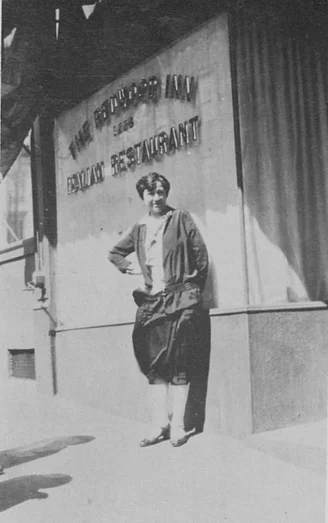
There was a period in 1925 when Vic and Mary left Humboldt County to live in San Francisco. While there, they operated the Redwood Inn.
In San Francisco Vic negotiated for a business on Grant Avenue which he named “The Redwood Inn.” Always able to adapt, Maria put the children in school in North Beach’s Italian community and the family remained there until 1928.
When they returned to Humboldt, Vic and Maria resumed the operation of the Big Four at Trinidad. As his business expanded, Vic started planning for a larger Big Four. He located property north of the Arcata city limits on Highway 101 and contacted Eureka architect Frank Georgeson with his ideas for floor plan and design. The Ed Lax Construction Company of Eureka contracted to build the 4,000-square foot English Tudor style inn, and the new Big Four opened in April of 1934. The building cost $12,500 to construct and an additional $12,000 was spent with A. Brizard’s for industrial fixtures and with Duck Brothers for additional furnishings. In addition to the large kitchen there was a central dance hall, 10 roomy booths, a large cocktail lounge, and a banquet room seating about 100. The building had an attached three-bedroom apartment for the family.
By now the restaurant was popular and attracted customers from the county. In spite of the Depression, the seven-course meal was still offered for 75 cents on weekdays and $1 on Sundays. Elba and Vicki waited on tables and helped in the kitchen as needed and niece Arminda Giuntoli and several young women from the Italian community lent a hand on busy weekends.
A few weeks after the opening of the new Big Four Maria was burned severely while lighting the gas jet in the steam table. “I felt like I was frying inside,” she said of the fiery mishap. “I think it was bad luck to move into the Big Four on a Friday.” She still uses the old country superstition to explain the misfortune. After several weeks at the hospital she was back in the kitchen, moving familiarly about in the heat and confusion of food, orders and people.
In 1948 Vic welcomed his brother Guido and wife Mary into the partnership. After 10 years of hard work and an ever-increasing clientele the couple was beginning to tire. Mary had had another accident in the kitchen, slipping on the tile floor and injuring her back, and Vic’s health was beginning to suffer from the steady grind of long days and infrequent vacations. In 1945 they decided to retire and sold their interest in the business to Guido. By this time both daughters had married: Vicki to Alfred Massagli of San Francisco and Elba to Sumner Kirby of Freshwater.
During the difficult transition from business to retired life the older couple resided with Elba and Sumner in Eureka for a few months. Maria busied herself with the household and her two granddaughters and occasionally Vic would join his son-in-law tending bar at the Club DeLuxe, which the Kirbys had opened in 1938.
Within a few months Maria and Vic began to feel restless and when Livio, Maria’s brother, proposed going into business in Garberville, they agreed. In 1946 the partnership opened the Village Inn, and as soon as Maria resumed cooking the crowds flocked to the restaurant on the main street of the small Southern Humboldt town. On a summer evening it was a common sight to see a jovial crowd waiting patiently in line in front of the Village Inn for one of Maria’s dinners. The menu remained virtually the same, although they raised prices to $1.25. By 1948 Vic’s health was again slipping and they sold the business to a Mr. Retzloff of Eureka.
Vic loved his automobiles and enjoyed taking his family on weekend trips about the countryside. Here he is in 1936 with his Oldsmobile.
When they left Garberville they decided to search for a home in the Bay Area so that Vic could obtain the medical care he required. They eventually located a large three-story residence in Kentfield in Marin County, which they planned to convert into two comfortable flats.
In the spring of 1952 Maria and Vic began planning a trip back to the old country. A few days before their scheduled departure they drove in Vic’s shiny grey Oldsmobile South across the Golden Gate Bridge to pick up their passports. Maria noticed that Vic was not looking well and later that day on the return trip home he pulled the car over to the curb, was stricken by a massive heart attack, and within several hours had died in a San Francisco hospital, Following a Catholic funeral he was interred at Mt. Olivet Cemetery in San Rafael.
Alone now, Maria began to look forward to family gatherings and it was not uncommon for 15-20 to gather for a birthday, holiday or Sunday dinner at the Kentfield home. Maria prepared for these occasions as carefully as she had ever done while in business. Now she set her tables with crisp linen, china, and carefully polished silver and crystal. For days prior to a celebration she moved with determination through shopping and cooking tasks until she had produced a feast of memorable proportions.
A year passed and in May of 1953 Maria declared that “If I don’t go now, I’ll never do it.” Passport in hand, she departed on a jet from San Francisco International Airport on her very first airplane ride, bound for Rome. She remained in Italy for five months traveling with her niece Laura, the daughter of her elder sister Gianina. She spent a month on the Italian Riviera, and traveled to the major cities of Europe, declaring her satisfaction with the comment that she had finally seen all the places she’d missed as a child. With characteristic generosity she showered her relatives with gifts and hosted large parties. When she returned home with shopping bags full of gifts and began reminiscing about the journey, she recalled with astonishment that her family in Italy had scarcely allowed her to lift a finger. As always, her modesty seemed to prevent her from placing undue significance on her own importance.
These days Maria spends her leisure tending a small garden in summer, entertaining friends and relatives, and involving herself in the activities of children, grandchildren and great- grandchildren. At 87, Maria still moves briskly about her kitchen tinkering with new recipes and gadgets and preparing old favorites. She visits Humboldt County frequently but resides permanently with Vicki and Al in a large comfortable home in rural setting in Novato.
When she looks back at the old days in Trinidad and Arcata, her busy hands pause a moment and she laughs at her own joke: “I suppose I have made enough raviolis in my lifetime to pave the highway all the way from Humboldt County to New York — well — maybe to Italy, if that’s possible!”
Epilogue
The Big Four Inn remained in the hands of Guido Evangelisti and his family. Over the years their three daughters, Dolores, Gianina, and Joanne, helped in the restaurant. Guide died in 1963 and Mary continued to operate the business with the help of Dolores and her husband Phil Citti until highway expansion in the 1970s forced closure. In 1972 the building was razed to make way for a new six-lane freeway, thus ending the history of a once-familiar landmark in Humboldt County’s social life.
###
The story above is excerpted from the May-June 1981 issue of the Humboldt Historian, a journal of the Humboldt County Historical Society. It is reprinted here with permission. The Humboldt County Historical Society is a nonprofit organization devoted to archiving, preserving and sharing Humboldt County’s rich history. You can become a member and receive a year’s worth of new issues of The Humboldt Historian at this link.
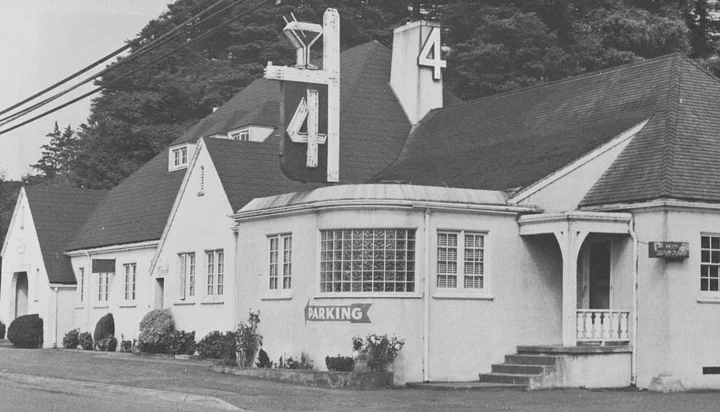
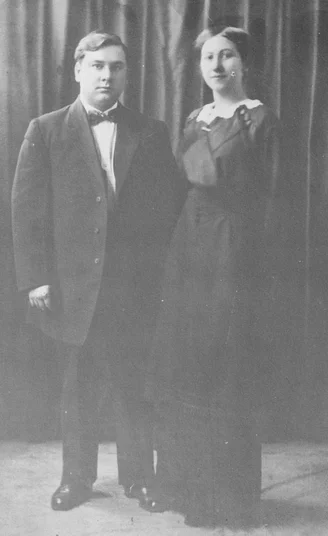
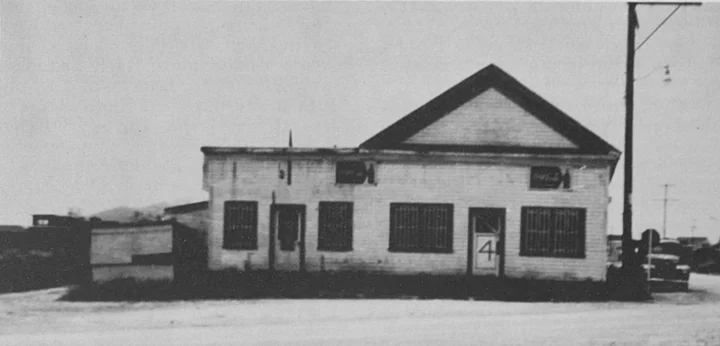
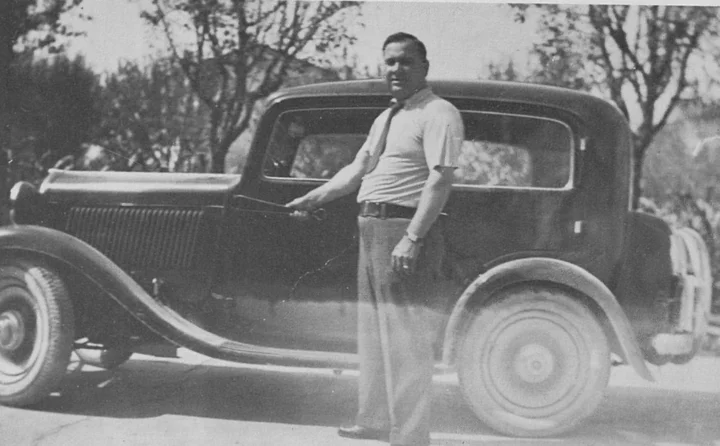
CLICK TO MANAGE